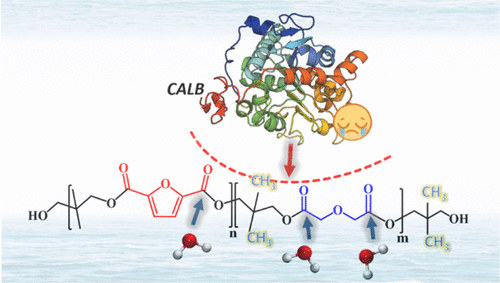当前位置:
X-MOL 学术
›
ACS Sustain. Chem. Eng.
›
论文详情
Our official English website, www.x-mol.net, welcomes your
feedback! (Note: you will need to create a separate account there.)
Design of High-Barrier and Environmentally Degradable FDCA-Based Copolyesters: Experimental and Theoretical Investigation
ACS Sustainable Chemistry & Engineering ( IF 7.1 ) Pub Date : 2021-09-15 , DOI: 10.1021/acssuschemeng.1c04687 Han Hu 1 , Jiayi Li 2 , Ying Tian 1 , Shenggan Luo 2 , Jinggang Wang 1 , Wu Bin Ying 1 , Fenglong Li 1 , Chao Chen 1 , Yi-Lei Zhao 2, 3 , Ruoyu Zhang 1 , Jin Zhu 1
ACS Sustainable Chemistry & Engineering ( IF 7.1 ) Pub Date : 2021-09-15 , DOI: 10.1021/acssuschemeng.1c04687 Han Hu 1 , Jiayi Li 2 , Ying Tian 1 , Shenggan Luo 2 , Jinggang Wang 1 , Wu Bin Ying 1 , Fenglong Li 1 , Chao Chen 1 , Yi-Lei Zhao 2, 3 , Ruoyu Zhang 1 , Jin Zhu 1
Affiliation

|
The 2,5-furandicarboxylic acid (FDCA)-based aliphatic–aromatic copolyester is an intensively researched area of bio-based polymers with high gas barrier and mechanical properties. However, the contradiction between the barrier and degradation performance still remains a huge challenge and severely limits their applications. Here, we combine branched neopentyl glycol, hydrophilic diglycolic acid, and FDCA to prepare poly(neopentyl glycol diglycolate/furandicarboxylate) (PNDF) copolyesters. With poor crystallization capability, PNDF40 and 50 (content of NF units) display low modulus (58 vs 108 MPa) but elastomeric behavior. Their tensile broken samples can even rapidly restore the original length, which might be derived from the physical crosslinking networks. It was interesting to find that even when more than 50% of the NF units were replaced by ND units, the PNDF copolyesters still retained high gas barrier. The introduction of diglycolic acid improved the hydrolysis rate, showing potential degradability under environmental conditions. However, enzymatic degradation using Candida antarctica lipase B (CALB) revealed that the branched neopentyl glycol decreased the biodegradation rate when compared with other linear diols. Furthermore, the hydrolytic pathway of PNDF was explored by density functional theory (DFT) calculation. Through Fukui function analysis, we identified the most active sites of PNDF for hydrolysis. Additionally, the calculated energy barrier indicated that hydrolysis of the polymer chain became easier with the increase in the number of ND units. Molecular dynamics (MD) simulations of PNDF–CALB illustrated that Val154 and Gln157 of CALB located at catalytic entrance formed noncovalent interaction with PNDF, which would sterically hinder the carbonyl carbon from reaching an ideal distance for nucleophilic attack and decrease the tendency to enter a pre-reaction state.
中文翻译:

高阻隔性和环境可降解 FDCA 基共聚酯的设计:实验和理论研究
基于 2,5-呋喃二甲酸 (FDCA) 的脂肪族-芳香族共聚酯是生物基聚合物的一个深入研究领域,具有高阻气性和机械性能。然而,屏障和降解性能之间的矛盾仍然是一个巨大的挑战,严重限制了它们的应用。在这里,我们将支链新戊二醇、亲水性二乙醇酸和 FDCA 结合起来制备聚(新戊二醇二甘醇酯/呋喃二甲酸酯)(PNDF)共聚酯。由于结晶能力差,PNDF40 和 50(NF 单元的含量)显示出低模量(58 对 108 MPa)但具有弹性行为。它们的拉伸断裂样品甚至可以快速恢复原始长度,这可能来自物理交联网络。有趣的是,即使超过 50% 的 NF 单元被 ND 单元取代,PNDF 共聚酯仍保持高阻气性。二甘醇酸的引入提高了水解速率,在环境条件下显示出潜在的降解性。然而,使用酶促降解南极念珠菌脂肪酶 B (CALB) 表明,与其他线性二醇相比,支链新戊二醇降低了生物降解率。此外,通过密度泛函理论(DFT)计算探索了PNDF的水解途径。通过福井函数分析,我们确定了 PNDF 最活跃的水解位点。此外,计算出的能垒表明,随着 ND 单元数量的增加,聚合物链的水解变得更容易。PNDF-CALB 的分子动力学 (MD) 模拟表明,位于催化入口处的 CALB 的 Val154 和 Gln157 与 PNDF 形成非共价相互作用,这将在空间上阻碍羰基碳达到理想的亲核攻击距离并降低进入预-反应状态。
更新日期:2021-09-27
中文翻译:

高阻隔性和环境可降解 FDCA 基共聚酯的设计:实验和理论研究
基于 2,5-呋喃二甲酸 (FDCA) 的脂肪族-芳香族共聚酯是生物基聚合物的一个深入研究领域,具有高阻气性和机械性能。然而,屏障和降解性能之间的矛盾仍然是一个巨大的挑战,严重限制了它们的应用。在这里,我们将支链新戊二醇、亲水性二乙醇酸和 FDCA 结合起来制备聚(新戊二醇二甘醇酯/呋喃二甲酸酯)(PNDF)共聚酯。由于结晶能力差,PNDF40 和 50(NF 单元的含量)显示出低模量(58 对 108 MPa)但具有弹性行为。它们的拉伸断裂样品甚至可以快速恢复原始长度,这可能来自物理交联网络。有趣的是,即使超过 50% 的 NF 单元被 ND 单元取代,PNDF 共聚酯仍保持高阻气性。二甘醇酸的引入提高了水解速率,在环境条件下显示出潜在的降解性。然而,使用酶促降解南极念珠菌脂肪酶 B (CALB) 表明,与其他线性二醇相比,支链新戊二醇降低了生物降解率。此外,通过密度泛函理论(DFT)计算探索了PNDF的水解途径。通过福井函数分析,我们确定了 PNDF 最活跃的水解位点。此外,计算出的能垒表明,随着 ND 单元数量的增加,聚合物链的水解变得更容易。PNDF-CALB 的分子动力学 (MD) 模拟表明,位于催化入口处的 CALB 的 Val154 和 Gln157 与 PNDF 形成非共价相互作用,这将在空间上阻碍羰基碳达到理想的亲核攻击距离并降低进入预-反应状态。











































 京公网安备 11010802027423号
京公网安备 11010802027423号